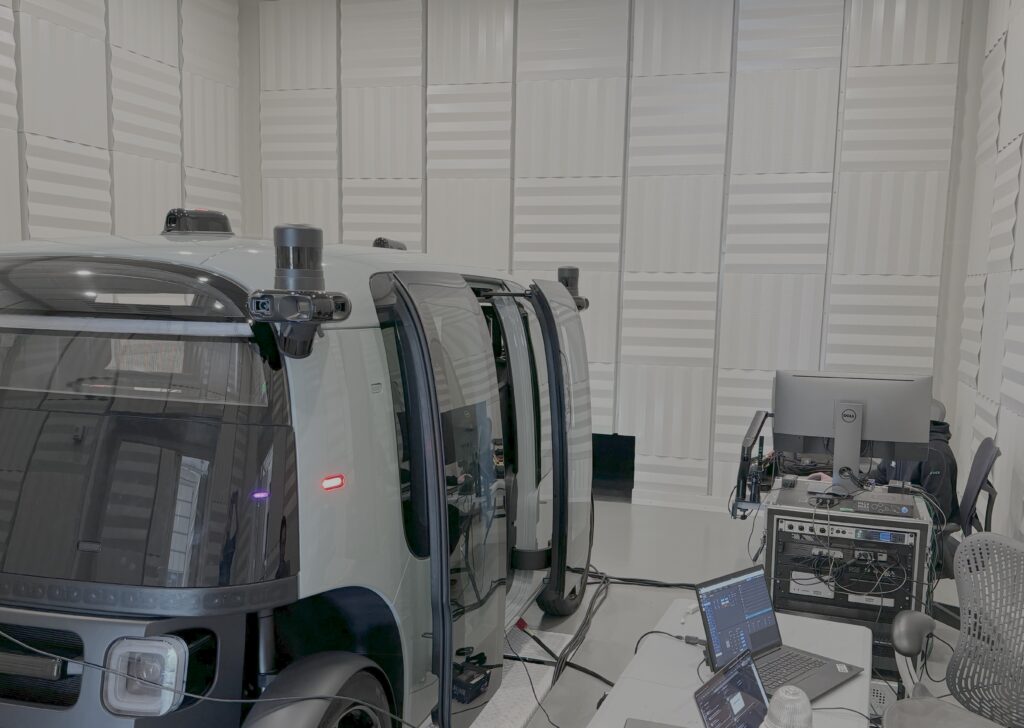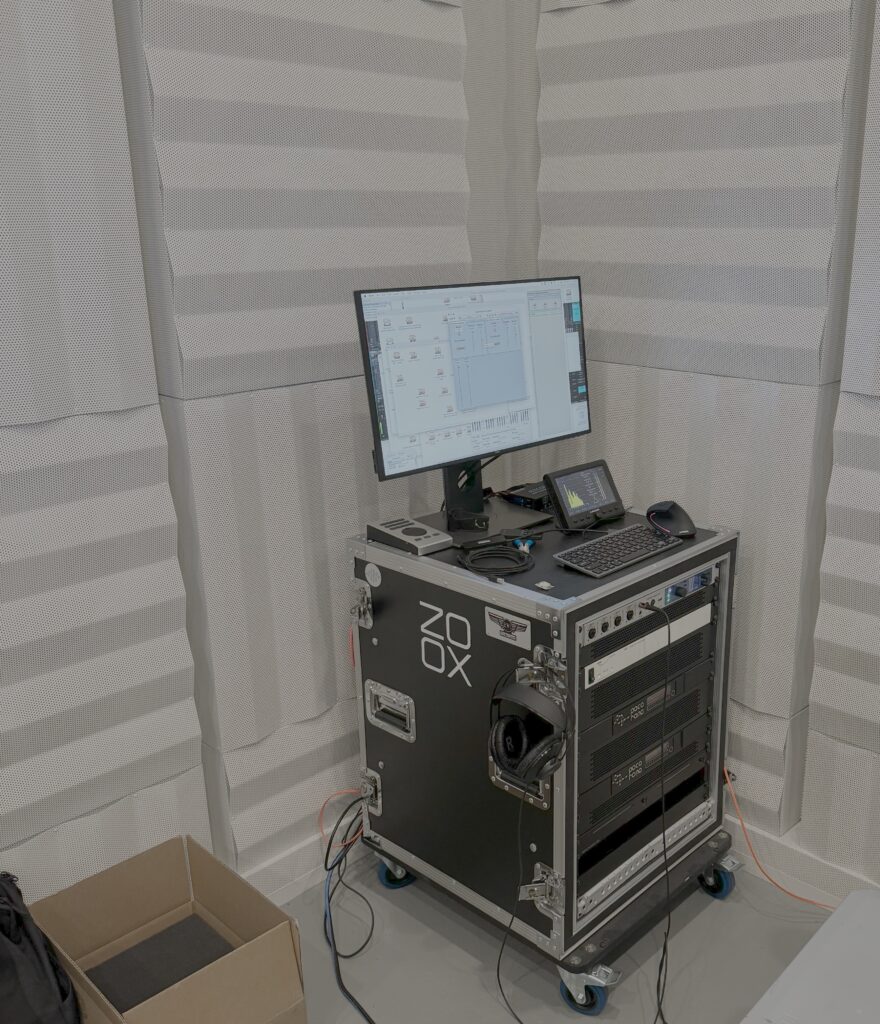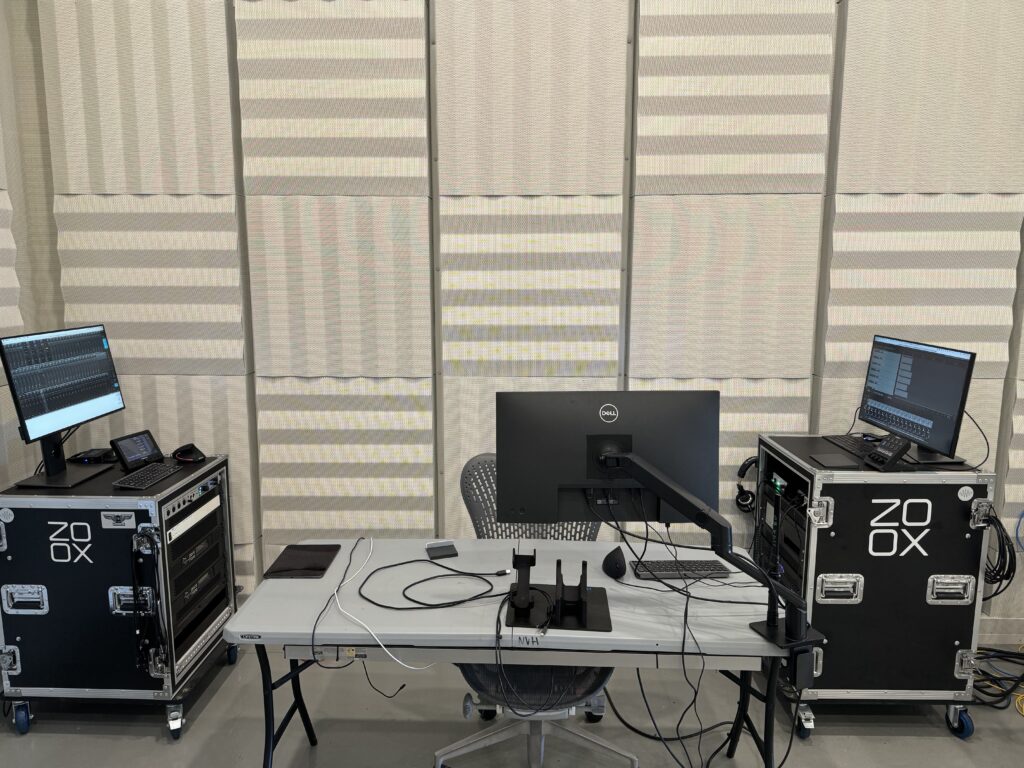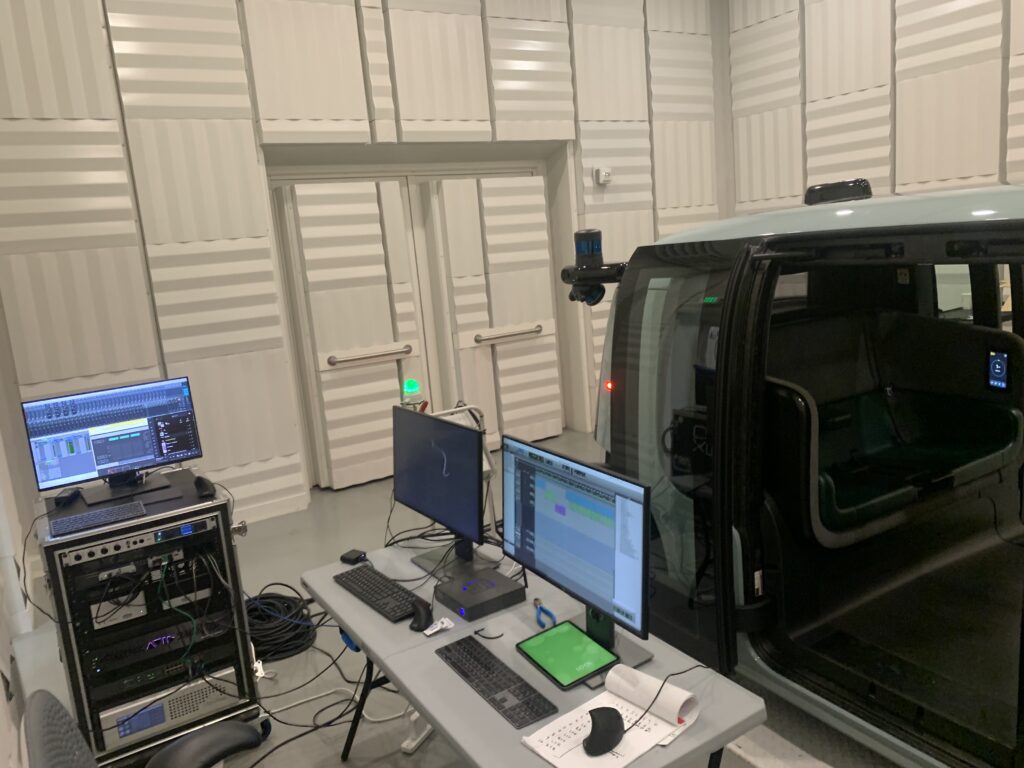Interview with Lowell Pickett, Senior Audio Engineer at Zoox
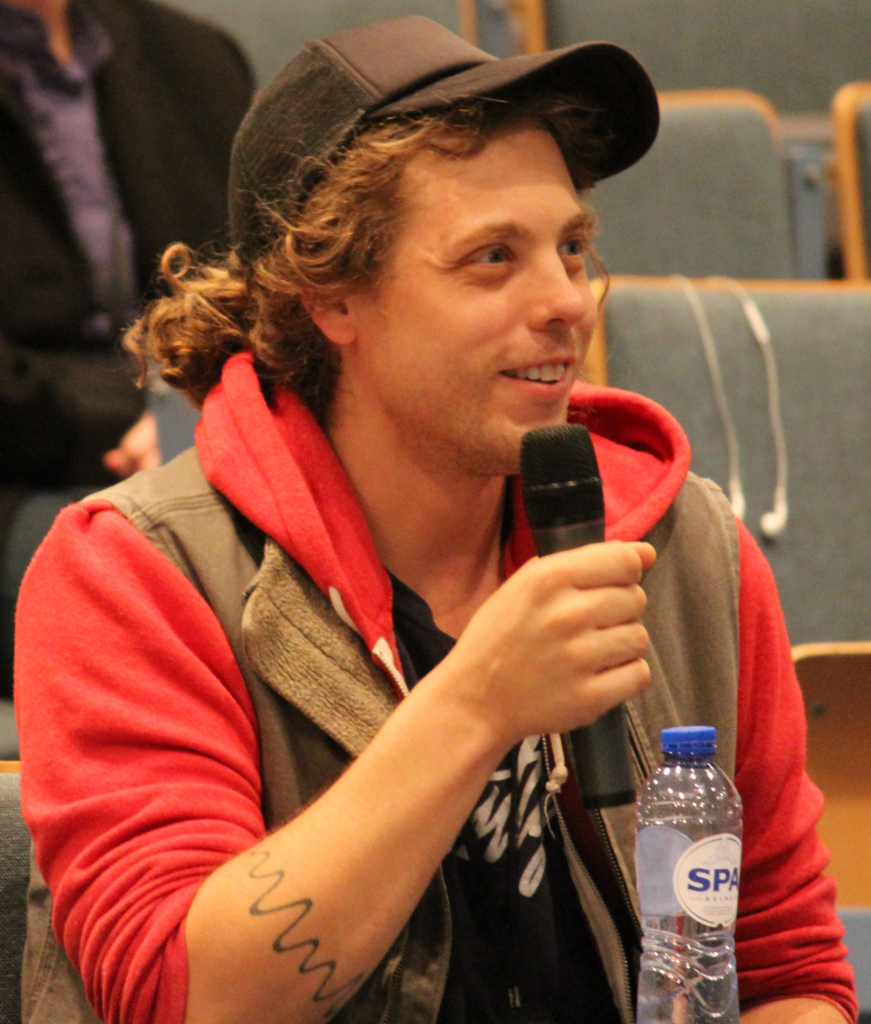
Every company should have an audio professional on staff!
—Lowell Pickett, Senior Audio Engineer at Zoox / Sound Lab
Eighth Nerve (EN): Yes! I agree 100%! Could I ask you to reflect on the skills and experience that someone from professional audio can bring to other industries (i.e., alternative applications of sound and audio)?
Lowell Pickett (LP): I often take my skills for granted, but the difference between a good-enough and a well-polished audio asset can truly impact engagement and can help to define a product when done well.
Sound is a ubiquitous component of our day-to-day, media-filled experience, and we often simply accept whatever audio quality might be convenient at any given moment – but sound has the potential to offer so much delight… In many situations where people have become accustomed to marginal audio quality – an old, well-used comms system perhaps or a family video that’s been watched many times – some applied audio knowledge can truly improve the (audio) quality of their life.
A well considered audio experience improves workplaces and recreational spaces alike – and a positive audio association with a brand or personal reputation can be a distinguishing characteristic.
EN: What is Zoox? How long have you been there, and what is the accomplishment you’re most proud of so far?
LP: I’ve been working for Zoox, an autonomous ride-hailing company, for about 6 years – and the culmination of that effort is something that I can quite literally look back at now and appreciate. Today, if you’re in the right part of San Francisco, Las Vegas or Foster City, you can hear these vehicles approach – broadcasting audio I’ve helped to develop – and turn around and look back at them!
In working on this project, my worlds have collided in ways that I never would have anticipated: I’ve been obsessed with cars/trucks/vehicles since I can remember, and I’ve been able to build off past audio explorations on a platform that would have been fantasy just a decade ago.
EN: What’s a typical day for you like at Zoox?
LP: On a typical day, I bounce back and forth between the studio at the company HQ in Foster City and assorted test platforms in the engineering wing, relating our designs from studio prototypes to real life on-hardware applications. I balance a modest schedule of meetings with hands-on audio/UX feature development projects.
Our exterior audio projects demand quite a bit of outdoor testing and this brings a welcome shift from the typically-indoor audio life as my teams regularly travel to vehicle testing venues.
EN: Can you describe a few of the sounds the vehicles make? What are some of your favorite sonic elements that people can be listening for? Are there different sets of sounds for the exterior versus the interior of the vehicle?
LP: We’ve been developing an interior experience for our riders as well as exterior audio behaviors that help our vehicle interact with the world at large.
One of my favorite sounds is one we call ‘Aura’ – it’s a relaxing, slowly swirling ambient bed that can be heard as a rider approaches the waiting vehicle. The exterior elements are different from what you hear on the inside, but complementary – so the auditory experience of entering the vehicle is a smooth and welcoming transition. This sound bookends the rider experience, so you would hear it as you exit as well.
I’m also fond of our exterior door chime – it plays on either end of the vehicle, directed towards the operating side. It’s a short puff of a sound that sits pleasantly in urban environments while effectively alerting those nearby to the moving door.
EN: Do you think that non-speech audio can convey meaning? Please say yes! 😉 Can you give some examples?
LP: Yes! And this is something my team is exploring! As our vehicle navigates it will need to communicate with the world around it – and we aim to apply audio with as little speech as necessary.
EN: Does Kyma play a role in your current work environment?
LP: Yes! Kyma plays a big role… a lot of the audio you hear on the vehicle was first prototyped using Kyma.
Kyma has always played a substantial role at Zoox’s SoundLab. When I started in 2019, there was already a Pacarana in the studio – a lot of early audio concept work was created in Kyma which has influenced the sound design present on the vehicle today. I gladly continued that tradition, and as our vehicle came to life, I persisted in prototyping various audio features using Kyma.
These days I use Kyma in several ways. On a basic level, I use Kyma to model systems within various hardware constraints; by building audio prototypes that consider specific control signal refresh rates and quantizations, I can try to exploit the reactive space within their confines.
Kyma has also played a role in our mix process where specific multi-channel panning and reverb processing is applied to complement our interior carriage seating arrangement and associated speaker placement.
On the exterior, Kyma was used to develop panning effects across our multi-speaker arrays for our passenger ingress and egress sequences. In these cases, it’s convenient to use the associated Kyma Control app on the iPad to create triggers and dial in parameters while connected to and working around our vehicle. It feels nimble to be able to work in the cabin or walk around the vehicle with just a lightweight control surface, and by extracting it’s GUI from the Kyma VCS, this pairing makes for quick control surface development for audio demonstrations.
EN: The symmetric design of the vehicle is super appealing! Did the symmetric cabin pose any special challenges (or offer opportunities) when it comes to audio?
LP: Yes! And actually, the inward facing arrangement of the cabin presented me with the perfect opportunity to apply some of the things I’d learned from my previous Kyma-based spatial performance environments!
EN: You mean like the portable immersive sound setup you presented at KISS 2010 in Vienna?
LP: Are you referring to ‘The Pentagon’?
EN: Yes! The Pentagon! Here’s an excerpt from your abstract (and a link to the video of your presentation):
The Pentagon – an experiment using Kyma for live 3D audio manipulation in the music venue of the future View Video The purpose of 'The Pentagon' is to present a new type of performance space that provides the audience with a unique social and musical experience in surround sound. The performer is positioned at the center of The Pentagon (in the middle of the audience) and uses Kyma to spatially mix and manipulate audio - alternatively, an assortment of performers can be positioned around the edges of The Pentagon. This experiment aims to heighten the audience's awareness of the real and virtual space around them.
EN: How is Kyma different from other audio software that you’ve worked with? Is there a reason why you continue to use it?
LP: There is something about the process that Kyma enforces that speaks to me: build it in the software, get it working with the hardware, interact with what you made, repeat with refinements. You iterate on what you have been creating in a way that is unlike how you’d ever approach a DAW or other electronic instrument. I find that this is relatable to hardware development where firmware is updated such that features may be created and/or tuned to be more ideally reactive, improving how they express incoming control signals.
EN: Can you give an example of how Kyma has come in handy for prototyping and iterative tweaking?
LP: Sure! When you’re working with automotive audio, many components run on a kind of local area network called the CAN bus. As a hypothetical, we might want to ensure control signals are going to work well at the lower update rate of the CAN bus. Something might sound great when the controls update once per millisecond, but we may also have to consider how that system sounds when the update rate is 0.5 s. In Kyma, we could simulate “downsampling” the control signals and tweak the smoothing and filtering until it sounds great in the target environment.
EN: Kind of like having a couple of small monitors in the studio to test that your music is still going to sound okay on broadcast radio?
LP: Exactly.
EN: Do you remember how you first heard about Kyma and why you decided to get it?
LP: Amongst the more curious publications that arrived at my house when I was growing up was the quarterly printing of Computer Music Journal from MIT press – my father had collected them for years, and they were archived on our bookshelves at home. I had started collecting my own music-making equipment while I was in high school, and I became interested in the multi-colored volumes. While I admit that a lot of the articles went over my head at the time, I always found myself flipping to the back pages where an assortment of somewhat recently released synths, samplers, interfaces or software titles were pictured and given a short review. In one issue (perhaps in ‘98?), [the] unique script on the Capybara 320 caught my eye and I was intrigued by the mysteries within its black box.
So I sent a letter in the mail to Champaign, IL to request a demo CD and figure out what Kyma was all about. That CD really blew my mind… I played it for all my friends – Carla’s voice resynthesized by a bank of oscillators, an assortment of spectral morphs, exotic filtering…
EN: Is this around the time when you were finishing high school or were you already at Cal Arts?
LP: I think this was around the same time I started my freshman year at CalArts. I was playing my electric cello a lot and looking for interesting ways to process my performance. My ‘beige’ 266 MHz G3 was a fine machine for the time, but it still often provided a bit of latency and a somewhat glitchy experience once you tried to stack up FX while processing in real time. I had been learning MAX/MSP and a bit of Supercollider, but I became convinced that Kyma’s processing capabilities were what I really needed for live performance. I spent the following summer working as a studio assistant at a Jingle house and saved up for my first system…
EN: What’s the most important thing you learned from your time at CalArts?
LP: CalArts prides itself on helping their students become independent artists, and I believe that those skills can be applied universally. I think CalArts provided me with confidence to work independently towards succeeding in whatever endeavor I might choose to pursue, even if I need to educate myself more along the way. I left feeling that I could coach myself through a creative process or other more technical developments. While I have faith in my ability to work independently, as a musician I’m also conditioned to work intuitively with peers as if we were in an ensemble.
EN: Any other fond memories of your time at CalArts?
LP: When I arrived on campus, I knew immediately that I was amongst my people. It was rumored that my freshman dorm room once was assigned to Tim Burton – the doorway had been uniquely stylized and the interior was equipped with student-built loft beds that made the room essentially a duplex. My roommate Nolan (who also became a Kyma user!) and I transformed the place with camo netting, Christmas lights and an array of borrowed / purchased / liberated speakers and audio equipment. It was a jam-room for live-electronics improv – I’m sure our neighbors hated us.
I had been playing classical cello since I was 7, but was looking for an exit plan. My music skills brought me to the school as a performance major, but I quickly plotted a course to sidestep into the world of music technology. I was fresh out of high school, armed with a small synth/sampler collection, a G3 computer, a new electric cello, and a ton of NYC attitude – bringing all that to the burbs of Valencia, CA was a bit of a culture shock.
Looking back, I remember training to achieve a state of flow while playing electric cello in Susie Allen’s improv classes – some of those sessions really surprised me in that there were moments where, out of nothing, a powerful musical moment was created that would only be captured in your personal memory – these are well carved in to my mind.
EN: Do you identify primarily as an artist? As an audio engineer? Both?
LP: [I identify as] an enthusiast – perhaps a professional enthusiast now – but it’s my enthusiasm for new audio experiences that drives me. I don’t really know that I would naturally call myself an artist OR an engineer – while I’ve worn these titles, they both feel a little uncomfortable to be honest. I can get caught up in making music or considering cinema – I can also get lost in living-room speaker placement and DSP-assisted room tuning – or listening to the ambience with my head tilted in various positions while my fingers bend my ears around…
EN: You’ve had a long career in the audio industry, and some of your previous jobs placed you in the role of “tech support” for a sound artist. How do you balance this role with your own creative work? Does technical support have some aspects in common with the role of mental health counselor? (As software developers, we often get to interact with customers when they are under their most stressful conditions — like just before a performance. Were you often working under similar conditions?)
LP: I absolutely relate to the role of mental health counselor! Unfortunately, I’m not academically qualified to list that on my resumé. When you are in a private setting with an artist for long periods of time, you are not just their tech, or engineer, or whatever… Some people foster an environment that supports feedback and discussion while others just want you to do what you were hired to do – and otherwise, keep quiet.
I try to keep my personal work experientially unique compared to what I am employed to do. That way, I feel like burn-out from one is somewhat fire-walled from the other.
EN: What’s your advice about how best to work in a supportive role for an artist?
LP: Listen a lot. Present feedback but not direction.
EN: Without naming names… describe your worst “client from hell” experience. What happened? How did you handle it? Would you do anything differently now?
LP: At some point, I had developed a bit of a reputation where my employers thought I was conditioned to deal with some of their most difficult artists or clients! I can be hard to crack, but I certainly have my limits. I don’t like to describe those experiences as “the worst” though; it’s more fun and less negative to think of them as the oddest…
EN: So I read that you sometimes did “house calls” for Westlake Pro (it almost sounds like a doctor 😉 ) Did you have any crazy or unexpected experiences making house calls and studio calls in LA (again, without naming names!)
LP: I frequently was hired as a contractor by a music retailer – and did house calls to support setup or training on whatever a customer may have been encouraged to purchase. Not all were professionals, and often, customers had acquired items that they struggled to understand and operate. They had dreams of making masterpieces nonetheless. I remember one such customer wanted me to teach them how to record with a mic into a DAW on their laptop – and following hours of slow and careful instruction, they procured a small crumpled leathery pouch. This was a whale heart, they told me – and they wanted to introduce this rare instrument to the world. They began to hum into the pouch/wad and move it frantically around their lips and mouth – then this hum turned into more of a wail with a bit of a gargle. The energy in the room changed, and I felt a bit concerned… After about 10 minutes, they were done with the take and put the ‘whale heart’ down. Happy with the results, they wanted me to come back the next week and record more of their songs with them, but I politely declined. Maybe they have a hit now?
EN: Conversely, describe a mountaintop, peak experience you’ve had in the audio industry.
LP: I think one of my more appreciated industry achievements came while I was working as lead tech at Chalice Recording Studios in Hollywood. After I started there, it became clear to me that our clients were critical of the main speaker systems in the flagship A and B mix suites. I talked the manager into investing some money to change things up a bit – I pulled out all of the analog crossovers and EQs and integrated modern, concert-sound subwoofers with digital processors with our large Augspurger / TAD in-walls. This was a big leap for a studio that was known more as a reflection of golden studio arts than a new technology adopter. Once everything was installed, cleaned up and tuned, the results spoke for themselves.
Chalice’s clients were very happy with the sound quality and clean bass in our rooms – word got out quickly that we’d made some improvements. Our manager had the rooms booked solid and I was getting asked quite a bit about the changes we’d made. There was a short feature on our update in an industry magazine and after a while, some studios across town started installing similar equipment.
EN: Dante or AVB? Do you have a favorite and why?
LP: Dante – there are more accessory switches that work with Dante right out of the box making for an easier setup – and it seems to have more support from manufacturers here in the US.
EN: Do you have a favorite audio interface? What makes it your favorite?
LP: The latest generation of NTP/DAD/MTRX Thunderbolt interfaces with FPGA have been game-changers for multichannel routing and level control across multiple I/O formats. The ability to use a Stream Deck and DADman to control these interfaces has made them flexible and configurable to match personal workflow preferences.
A DAD Core256 can really tie a studio together – especially considering the Pacamara! I use the inexpensive MiniDSP MCHStreamer Box with the Pacamara – and work with 8 channels of 48k ADAT I/O from Kyma. The Core 256 (or larger interfaces) can bring that ADAT stream back into my DAW over Thunderbolt and/or route the signals to any other MADI/Dante connection point with remarkably low latency – all at the touch of a button/knob on my Stream Deck.
EN: Favorite near-field studio monitors?
LP: I have become partial to PMC’s Result 6 active monitors. I like their fancier models as well, but their entry near-field has become a familiar tool for me that is easy to place on a desk for relatable results in bedroom studios and professional rooms alike. I am impressed by how well they reproduce clean bass despite their size, apparently thanks to their ‘Advanced Transmission Line’.
EN: You also worked with Dr. Henry Nicholas (Broadcom founder) for a period of time. At SSC we think of him as Dr. Ethernet! What kinds of research and application development did you do for Henry Nicholas’ studio?
LP: I signed an NDA for Dr. Nick’s company when I left (it’s been over 10 years now)… But one feature of working at his facilities that I am allowed to talk about is that I had access to a fully loaded Capybara 320, installed to support a 7.1 surround mix room – that setup really got me hooked on working with Kyma and multi-speaker setups.
EN: What TV shows did you work on with composer David Vanacore?
LP: There were so many! But I’d say his work with Mark Burnett felt most exciting to engage with – I regularly re-arranged his themes to fit weekly segments of ‘Survivor’, and it was fun engaging with his massive collection of sampled instruments to accent spicy moments during the ‘Tribal Council’ scenes.
EN: Were you working with Howard Shore when he composed the score for Lord of the Rings? (That score is so beautifully melancholy — did it make you feel sad to be hearing that music all day at work?)
LP: I worked with Howard Shore not long after I graduated from CalArts – he was already working on the second movie in the series at that time, The Two Towers. And yes, I think the melancholy nature of the music may have set some moods… especially as the seasons turned to fall and winter at his up-state New York facility. Recently, I rewatched the trilogy with Lawrence; it had been over 2 decades since I’d experienced LOTR, and it felt as epic and exciting to me as it did originally!
EN: Can you describe the project you did with Allison Goodman involving an EEG headset and memory-evocative soundscapes. (I witnessed someone literally moved to tears while experiencing the sound installation you guys created for KISS 2013 in Brussels. Did you ever consider using the combination of sounds and EEG as a form of music therapy?)
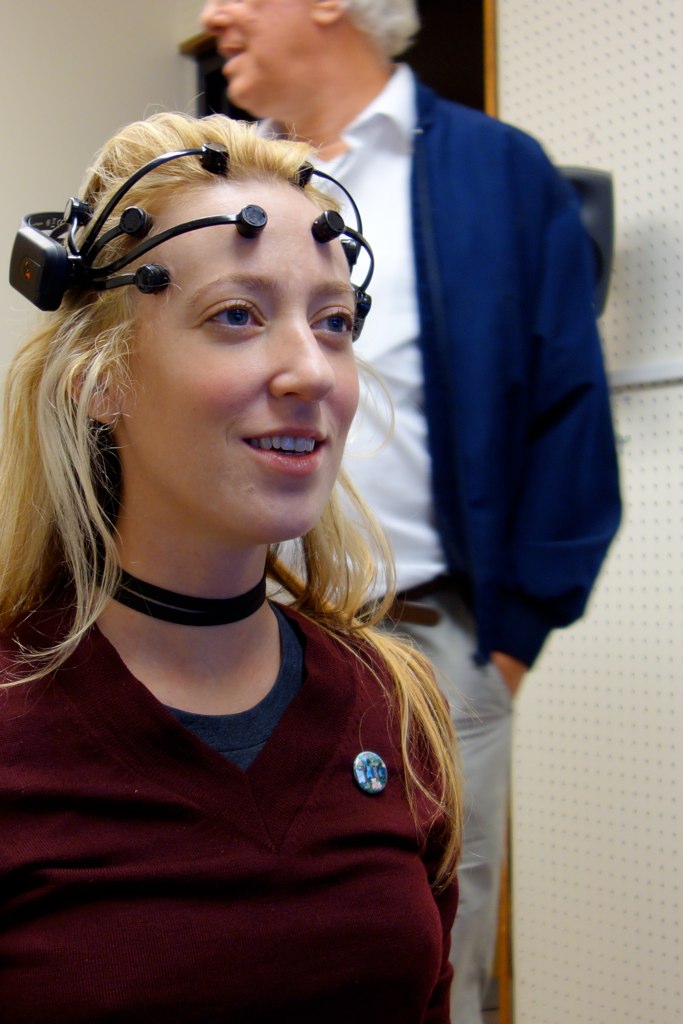
LP: This was our first time collaborating! The concept was straightforward – Allison found or captured sound that appealed to her and related to personal memories – we had a small PCM recorder that she used around our neighborhood in LA to collect audio that she felt spoke to our life there. These sounds were sequentially presented over a looping background arrangement of cello recordings I’d provided. She was mixing the performance live in her head! The idea was that sounds she could personally relate to could inspire an emotional response that was picked up on the EEG Headset – and then mapped to control a combination of volume, radius, reverb mix and rate of spin of various sound elements that whirled around the theater in Quad.
Allison is able to connect with people on an emotional level very quickly – and this headset seemed to amplify her powers! Working with EEG was an interesting experience, but after seeing more than one emotional response such as you described, we felt that there was something powerful going on that we needed to be careful with and understand a bit better.
EN: When your son Lawrence was born, did it change the way you look at life and the world? Or was it a more incremental change when he joined you on the journey?
LP: I’d say it was a massive change – and it really made me look at the life that my wife Allison and I had enjoyed as a couple in Los Angeles. We asked ourselves if that world was what we wanted young Lawrence to grow up in – and in the end we couldn’t convince ourselves that it was… so a year after he was born, we concluded that chapter of our story in LA.
EN: California, New York, or Texas? Which do you call home? (Or somewhere else not on this list?)
LP: I’ve spent more than half my life in California now – but not all in the same region. I’d need to use your tachyon field to revisit the New York I was familiar with, yet still I’m way too much of a Yankee to spend too much time in Texas (they all can tell!). California is home today!
EN: If a 19 old approached you today, seeking advice on the best route to working in the audio recording industry, would you discourage or encourage them? What route would you advise them to take?
LP: I would never intentionally discourage them – but I would be honest in relating my experience, whatever impact that might have. A lot has changed since I got started – there are now audio positions that didn’t exist when I was younger in industries that I hadn’t considered. I would suggest that they cast a wider net and look beyond the audio recording industry. There are amazing opportunities in technology and media development that are outside of the traditional entertainment industry where the culture can be different. I will always be connected to the music biz, but it can feel like a service industry; that’s something young people should consider.
EN: Do you think your son, Lawrence, will be a musician? Or is he clearly headed down a different path?
LP: Music appreciation is in his bones – and it makes him sing and dance all day. He’s not so interested in musical instruments or taking lessons, but his life seems to be scored to an internal soundtrack that he moves along to. A joyous path to somewhere – maybe a career in music, maybe not – but along the path itself, there will be music and dancing!
EN: Do you believe that you will ever visit another planet? Will Lawrence?
LP: I will not be visiting any planets – but it’s not the planets’ fault, more the method of transport needs improvement. I dread long flights – so spacecraft would have to advance to become much more enjoyable than commercial air travel, or even ocean cruise-lines. It doesn’t look like the International Space Station or Dragon capsules are all that comfy today – and we aren’t able to project ourselves instantaneously via some cosmic beam. Lawrence on the other hand may be visiting planets already, behind my back without me knowing.
EN: What area outside of audio would you most like to learn about over the next 5 years?
LP: I’ve been living in the SF bay area for over 8 years now – I cross the bay almost every day and I am frequently along its perimeter. I’m tired of being a spectator and I think I’d like to learn how to sail and operate a boat.
EN: What are you most looking forward to in the immediate future?
LP: I’m excited for these bots [Zoox automonous taxis] to make their way in the world and contribute to our urban sound-scapes – and I’m excited for people to experience the unique in-cabin sound experience on board as well, as we prepare to start welcoming our first customers!
EN: Were you guys at the Consumer Electronics Show in Las Vegas?
LP: Zoox did indeed have a booth at CES this year, and we’ll be welcoming our first public riders later this year in Las Vegas and San Francisco.
EN: I’m eager to give it a try! I think of you guys every time I look out over a vast parking lot filled with cars that go virtually unused for 8 hours a day. An on-call robo-taxi makes so much sense (and whoever designed your vehicle made it look almost cuddly and adorable, like a puppy!)
